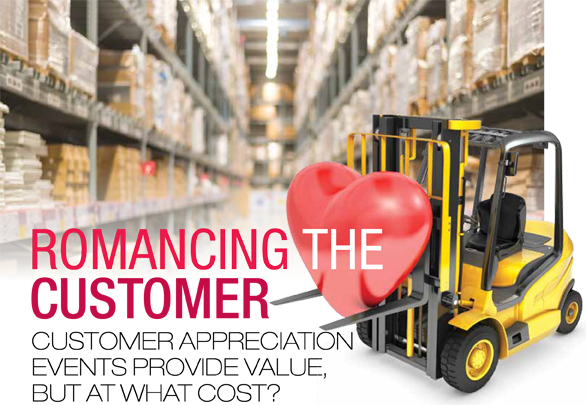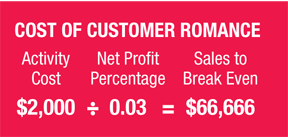Romancing the customer

by Jason Bader
Showing a little love to your best customers is a time-honored tradition. With so many challenging moments in the business cycle, it’s nice to get away from the confrontation and conflict every once in a while. Some may argue that your best customers, the ones that make a positive contribution to your bottom line, need to be retained and nurtured at all costs. But do we really know where to draw the line? Is there a tipping point when the cost to retain exceeds the return on investment?
I recently spoke with a client about an event he was planning with one of his largest customers. He explained some of the thinking behind the selection of the customer, the purpose of the event and ultimately the activity. Let’s start with the fun stuff. The event was a driving school where participants had the opportunity to get professional instruction in a private setting. The decision to go with a driving school was part luck and a little bit of science. The luck came in the form of my client and the customer’s shared interest in motorsports. The science was suggesting an event that would produce a shared endorphin rush experience along with an opportunity for both companies to recognize opportunities for mutual prosperity.
Before the event, the companies met for half a day to discuss where these shared opportunities could be realized. This meeting is a critical step to realizing the return on investment. It should not be a secondary thought to the fun side. It requires planning, strategic thought and perhaps a little outside help. This last point is where my client took this activity to a different level. In order to maximize this face-to-face opportunity, the client reached out to a marketing company for assistance. One of the key takeaways from this investment was how to talk about themselves.
There is a natural tendency to want to pour through the history of the company and how it has expanded over time. Conventional wisdom suggests that history shows strength and stability. Unfortunately, an overemphasis on history tends to have a negative impact on the audience. News flash, they really don’t care that you are a third-generation family business with roots back to WWII. They don’t care that you started in a barn and now have 15 locations. What the customer really cares about is what you can do for them right now.
Taking cues from the professional counsel, my client crafted a meeting presentation that emphasized investment where they were aligned with the target customer. They talked about how such investments were geared toward helping the customer improve profitability. Moreover, they created a presentation where the customer was encouraged to speak about their goals and future direction. My client’s team was coached on active listening and the use of open-ended questions. Essentially, the marketing company taught them how to position themselves in a customer-centric manner.
The customer was selected based on sheer size and perceived potential. Part of the thinking was to thank them for past business. The gross margin dollar contribution was significant. This thinking is a slight departure from what I often recommend but I am not naïve to the notion that big customers often get the big attention. When selecting the right customer for this type of event, I generally suggest that the client should select one of the most net-profitable relationships. Determining net profitability is an exercise I have written about several times and would be happy to share upon request. For this discussion, suffice it to say that bigger customers are not always your most net profitable. A small- to mid-sized volume customer can do more for your bottom line than the behemoth that plays you like a fiddle.
The event selection was nothing incredibly scientific on the surface but if you look at what occurred, the activity might be slightly brilliant. Over the course of my career, I have been on the receiving end of various forms of supplier appreciation. Rebates, spiffs and gift cards have always been a welcome gift. Hey, who doesn’t like a little walking around money? Edibles ranked a little higher than logo swag, but it was all appreciated. Unfortunately, these forms of customer appreciation did not form a lasting impression. The gifts that made the greatest impact, and a lasting memory, were those times involving a shared experience.
Shared events are a great way to connect with a customer in a meaningful way. As I look back over my career, I remember events large and small. Furthermore, I remember who was there, the conversations that took place and how I felt. In looking at the selection of a driving school, you can see how an adrenaline-laced event will make a lasting impression on all those who participated. Don’t get lazy and send them to a ball game, go with them. Create that opportunity for a shared experience.
Now that we have reviewed the warm and fuzzy part of the appreciation activity, it’s time for the wet blanket. Shared experiences cost money. It can be money well spent but let’s not overlook the fact that customer appreciation takes a chunk out of the bottom line. Because we know there is a cost, responsible companies go into these activities with a goal for a return on that investment.
Fortunately, understanding how to recoup this investment just requires a little math. The cost for one of these events is a direct hit to the bottom line, so let’s start there. The first thing you want to bring to the evaluation is an understanding of your net profit to sales ratio. For most distributors, net profit before taxes will range between 2 to 5 percent of sales. Ask your financial officer for this percentage. Next, determine the approximate cost of the appreciation activity. Divide the cost of the activity by your net profit percentage to determine how much additional revenue you need to cover the original cost. Here is an example. Let’s say that the proposed activity will cost $2,000. Your net profit percentage is 3 percent. Here is the formula:

What the math is telling us is that we need to generate at least $66,000 more top-line sales dollars from this customer, over the next 12 months, in order to break even on our investment. And, the air has left the room. This is a harsh reality for folks who love to entertain customers, but the math doesn’t lie. I am not saying that this should cause you to avoid investing in customer appreciation. I am simply asking you to set a goal for the return on investment.
The reality is that you are going to romance customers regardless of the cost. It is in your nature and there are several non-tangible benefits to the activity. The benefits are tough to quantify, but they are real nonetheless. Planning the investment in customers should involve a realistic selection process, respect for the cost and a purpose for the investment.
If I can leave you with anything, don’t underestimate the power of that shared event. The quote in my wife’s email signature brings this point to a meaningful close: “People will forget what you said, people will forget what you did, but people will never forget how you made them feel.” Good luck and I am always here to help.
 Jason Bader is the owner of The Distribution Team, which specializes in helping distributors become more profitable through strategic planning and operating efficiencies. For more information, call (503) 282-2333 or contact him by email at Jason@Distributionteam.com or visit www.thedistributionteam.com.
Jason Bader is the owner of The Distribution Team, which specializes in helping distributors become more profitable through strategic planning and operating efficiencies. For more information, call (503) 282-2333 or contact him by email at Jason@Distributionteam.com or visit www.thedistributionteam.com.
This article originally appeared in the March/April 2018 issue of Industrial Supply magazine. Copyright 2018, Direct Business Media.













